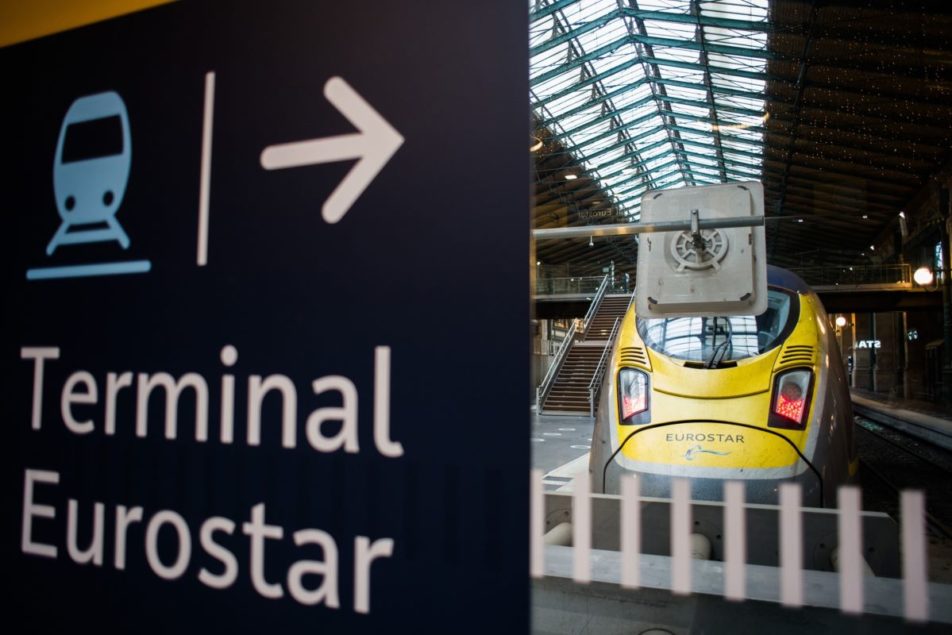My understanding regarding the planned regulations for US-Canada trains is that a designated station (Vancouver & Montreal) handles all customs & immigration in both directions, then the trains run sealed to the border. If this system is not the case, then I sincerely hope they head this way! This system doesn't solve circumstances like trains to Toronto, though.
And if they ever instituted a service where the US side was the "sealed" end, I'd expect the same system in place (I think Detroit or Buffalo would make good stations for service into Canada).
It would take the form of US pre-clearance, which you may have experienced if you fly to the US from most major Canadian airports like Toronto, Vancouver, Montreal and some other places like Dublin Ireland and Abu Dhabi. You clear US immigration and customs while still in the departure country, where you are sequestered from other passengers having legally if not in fact entered the US. On a flight you would arrive as a domestic passenger, in a domestic terminal, without having to clear customs on arrival - which means you can fly from Toronto to a US airport that doesn't have a CBP station like LaGuardia.
The same would occur on a train - you would "enter" the US at Montreal Central, and the train would then not make stops until after crossing the border - the stop at St. Lambert would be dropped. Your arrival in Plattsburgh NY, and the miriad small towns would then be as a domestic arrival. Going the other way, the train is sealed from the border until you arrive at Montreal Central, and you'd go through the CBSA station there. Practically, you'd need a platform that is physically separated from the others, as well as a sterile waiting area for cleared passengers.
Legally speaking, the enabling law for this was passed by both countries in August 2019, with Montreal Central one of the priority installs, but with cross border trains suspended there was no movement on actual implementation. Canada also has the right to operate pre-clearance facilities in the US, but with the relative disparity in traffic concentration has never actually done it.
Right, these options both make sense for trains into Montreal and Vancouver, but Toronto is the hard one because it's a much longer journey between the border and the station. So yeah, it sounds like it would have to be the non-stop model that
@HenryAlan describes, which seems workable between London and Paris, but harder between anything except
maybe New York and Toronto.
I’m no expert, but how about introducing designated international cars on these trains? An intermediate car could have customs for passengers to pass through before getting onto the international cars. It would require careful coordination. Is that crazy?
Oh huh, that's an interesting idea. No clue if it could be feasible. I will say that it has the general ring of "Something the US Does That No One Else Does But Which Kinda Works."
More generally though, I am intrigued by the possibility of moving the customs process
on to the moving train. For example, passengers could board on the normal platform at NYP; the train could then run non-stop (or I guess near non-stop) to Albany, during which time customs inspectors can move through the train; anyone who doesn't pass inspection can detrain along with the inspectors at Albany, while the rest of the train continues non-stop to the Canadian border, after which it can make all intermediate stops between Niagara Falls and Toronto. A similar process could be done coming from Toronto, with inspectors and unapproved travelers detraining at the border to return to Toronto.
(I suppose you could do a similar thing with a non-stop train from Boston that does its inspections during a non-stop run between Boston and Albany, before being combined with the other set of inspected cars from New York.)
I worry about losing out on intermediate ridership, but I suppose there are ways around it: travelers from upstate NY could, for example, take a separate domestic train to Niagara Falls, go through customs there, and then board the international train along with the pre-checked passengers.
The other thing to consider is that it's currently a
12-hour train trip between New York and Toronto. That includes an average of 1 hour for customs (more going to the US, less going to Canada), so perhaps an Onboard-Customs journey could trim that down to 11 hours. I wonder if there could be a market for an overnight train under that model. Depart either end around 7 or 8, customs are completed by 10pm, arrive at the destination the next morning around 7 or 8.

